Join Cultural Samvaad’s WhatsApp community
The Constitution of India is the supreme law of an independent India. It has the distinction of being the longest written constitution of any democratic country on the earth.
इस विडियो को हिन्दी में देखें|
Making of the Constitution
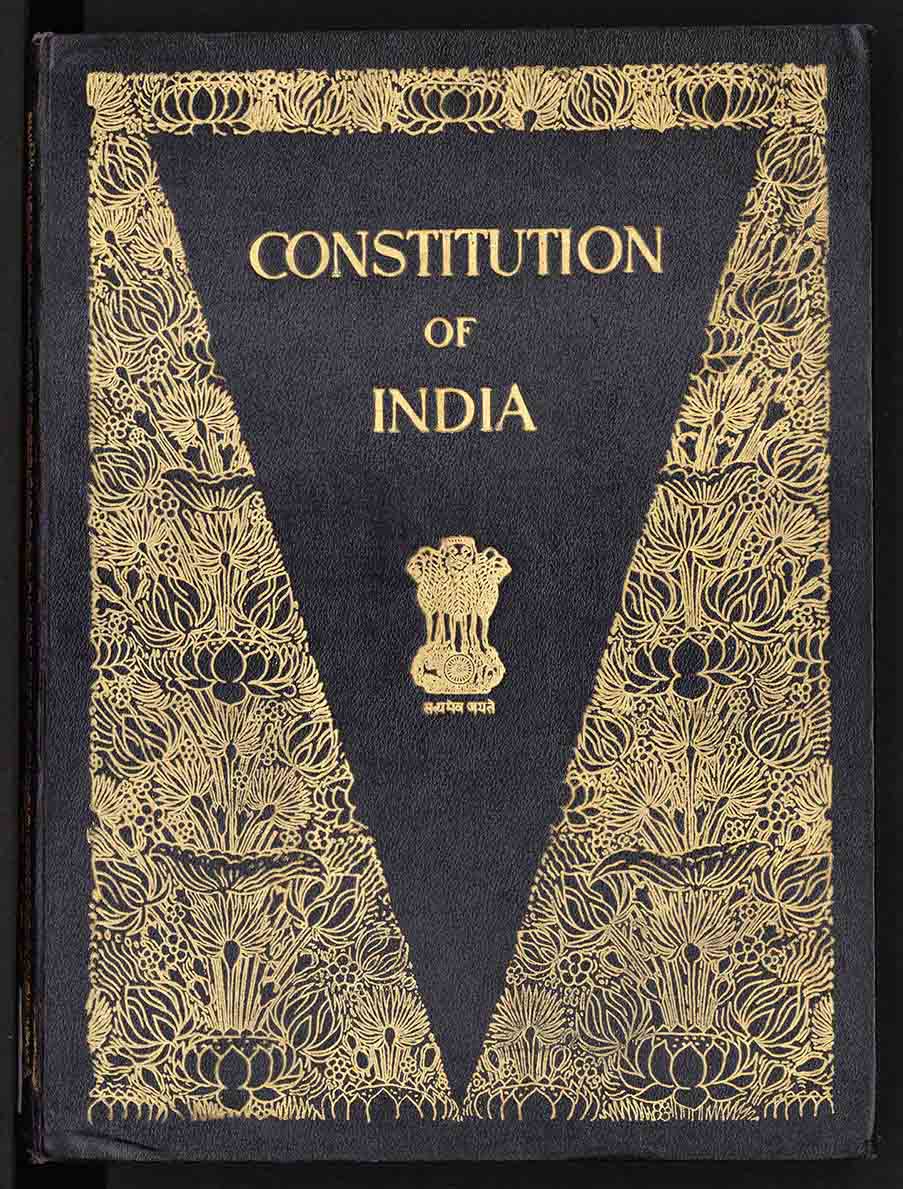 The Constitution of independent India represents the will of the people. It was prepared by the Constituent Assembly which began this monumental task in December 1946 in New Delhi and took a little less than three years to complete it. The Constituent Assembly which had 299 members (after the partition of India) discussed and deliberated over each clause of the constitution and arrived at decisions by consensus.
The Constitution of independent India represents the will of the people. It was prepared by the Constituent Assembly which began this monumental task in December 1946 in New Delhi and took a little less than three years to complete it. The Constituent Assembly which had 299 members (after the partition of India) discussed and deliberated over each clause of the constitution and arrived at decisions by consensus.
The Assembly adopted the Constitution of independent India on the 26th of November 1949 and the Constitution came into effect on the 26th of January 1950. To commemorate these two momentous events in the long history of our nation, 26 November is celebrated as Constitution Day while 26 January is celebrated as Republic Day.
The Preamble
The Preamble to the Constitution commences with the magical words – ‘We, the people of India’. It captures the lofty spirit of our Constitution and the ideals and aspirations of Indians. India is a Sovereign. Socialist, Secular, Democratic, Republic, which assures the dignity of the individual and the unity and integrity of the nation. The nation recognises justice, liberty and equality as basic principles of her citizens’ lives and seeks to promote fraternity among them.
The Supreme Court of India has upheld that the Preamble is an integral part of the Constitution.
Take a short Quiz on the Constitution of India
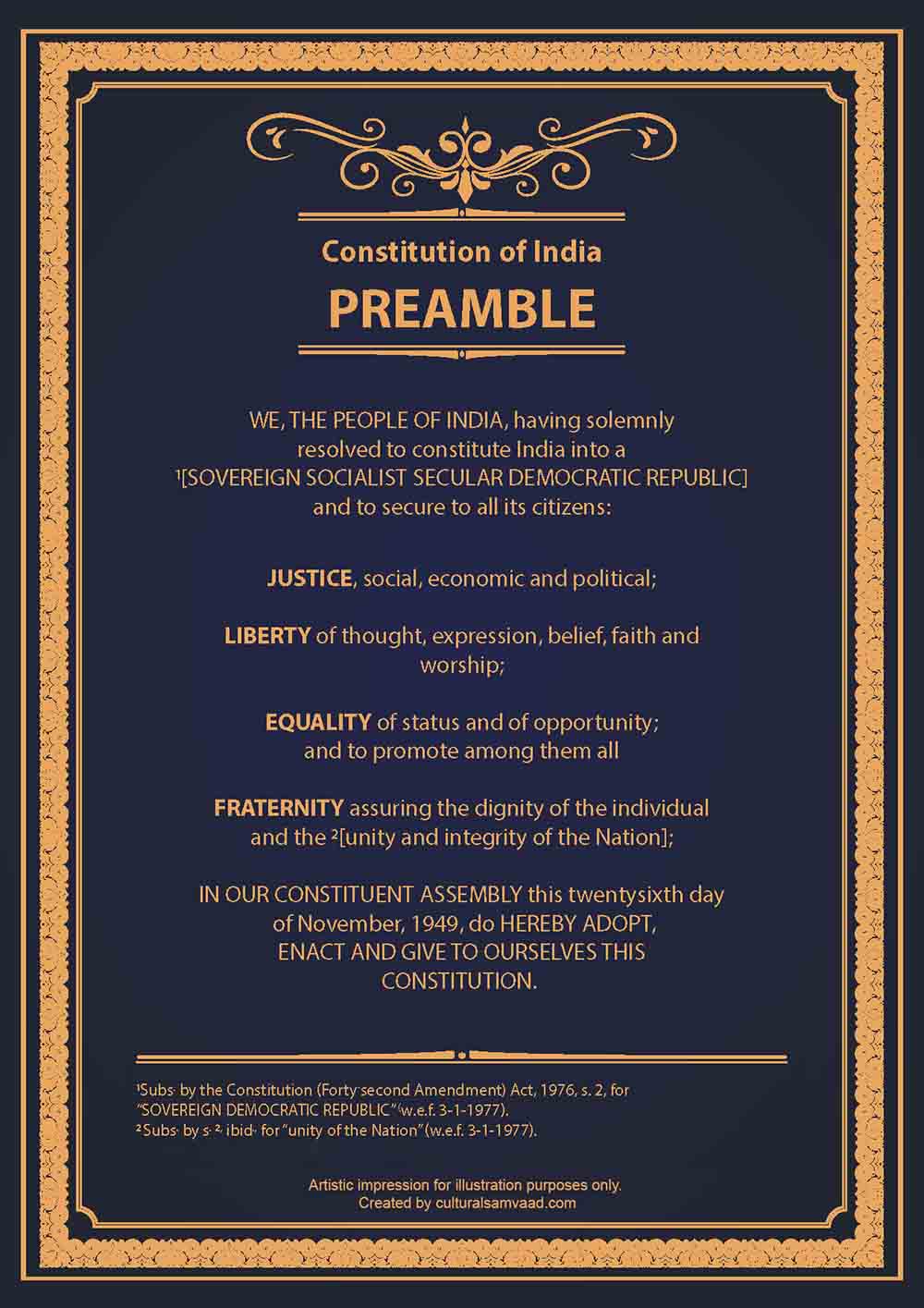
Our Constitution and Governance of the Indian State
Our Constitution establishes India as a ‘union of states’ with a parliamentary system of democracy. All adult citizens have the right to vote without any discrimination on any grounds, making universal adult franchise a hallmark of our democratic system. It is important to reiterate that each citizen has one vote each and each vote carries equal weightage in the eyes of the Constitution.
As per the provisions of our Constitution, there are three organs of government – legislature, executive and judiciary. These three organs work in tandem to ensure the governance of the nation and the welfare of the people. The legislature makes/enacts laws, the executive implements laws and the judiciary interprets laws within the limits set down by the Constitution. The executive and the legislature represent the will of the people while an independent judiciary serves as the conscience keeper of the nation.
22 Paintings in the Original Manuscript of the Constitution of India
Fundamental Rights, Directive Principles of State Policy and Fundamental Duties – The Conscience of the Constitution
“The Indian Constitution is first and foremost a social document. The majority of its provisions are either directly aimed at furthering the goals of the social revolution or attempt to foster this revolution by establishing the conditions necessary for its achievement…the core of the commitment to the social revolution lies in Parts III and IV, in the Fundamental Rights and in the Directive Principles of State Policy. These are the conscience of the Constitution.” (Austin, 2019)
Fundamental Rights
Fundamental Rights enshrined in Part III (Articles 12-35) of the constitution and are protected and guaranteed by the constitution itself. They are essential for leading a dignified existence as stated in the Preamble and are enforceable in courts of law. Fundamental Rights not only protect individuals from arbitrary, prejudicial, state actions, but also protect them against actions of other individuals. The following Fundamental Rights are guaranteed by the constitution.
1. Right to equality (Articles. 14-18)
- Equality before law.
- Prohibition of discrimination on grounds of religion, race, caste, sex or place of birth.
- Equality of opportunity in matters of public employment.
- Abolition of Untouchability.
- Abolition of titles
2. Right to freedom (Articles. 19-22)
- Protection of certain rights regarding freedom of speech, etc.
(a) to freedom of speech and expression;
(b) to assemble peaceably and without arms;
(c) to form associations or unions;
(d) to move freely throughout the territory of India;
(e) to reside and settle in any part of the territory of India; and
(g) to practise any profession, or to carry on any occupation, trade or business.
- Protection in respect of conviction for offences.
- Protection of life and personal liberty.
- Right to education.
- Protection against arrest and detention in certain cases.
It is to be noted that the Supreme Court of India has ruled that the ‘Right to Privacy’ is an integral part of the right to life and personal liberty guaranteed in Article 21 of the Constitution
3. Right against exploitation (Articles. 23-24)
- Prohibition of traffic in human beings and forced labour.
- Prohibition of employment of children in factories, etc.
4. Right to freedom of religion (Articles. 25-28)
- Freedom of conscience and free profession, practice and propagation of religion.
- Freedom to manage religious affairs.
- Freedom as to payment of taxes for promotion of any particular religion.
- Freedom as to attendance at religious instruction or religious worship in certain educational institutions.
5. Cultural and Educational Rights (Articles. 29-30)
- Protection of interests of minorities.
- Right of minorities to establish and administer educational institutions.
6. Right to constitutional remedies (Articles. 32-35)
This right deals with remedies for enforcement of rights conferred by Part III. It includes the right to move the courts to issue directions or orders or writs for enforcement of rights.
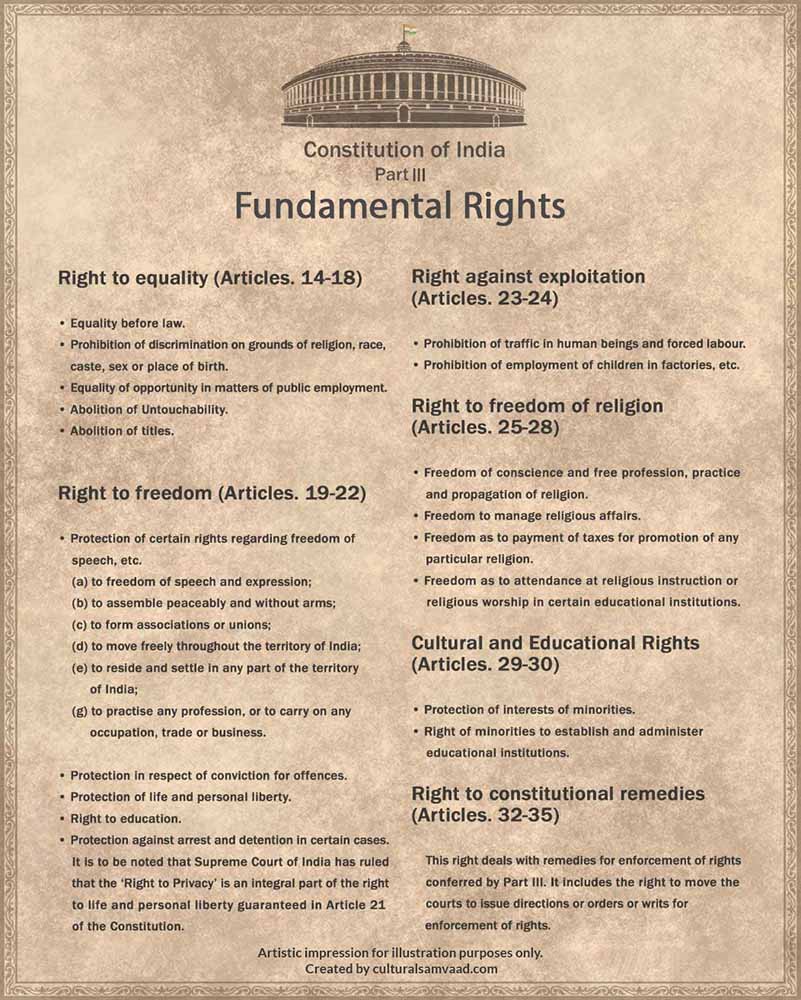
Directive Principles of State Policy
The Directive Principles of State Policy are not justiciable which means that they are not enforceable by courts of law. They are, however, fundamental in the governance of the nation. It the duty of the State to strive to apply these precepts in formulating laws to establish a just social order and to promote the welfare of the people. The essence of the Directive Principles is mentioned in Article 38, which reads:
“…the State shall strive to promote the welfare of the people by securing and protecting as effectively as it may a social order in which justice, social, economic and political, shall inform all the institutions of the national life.”
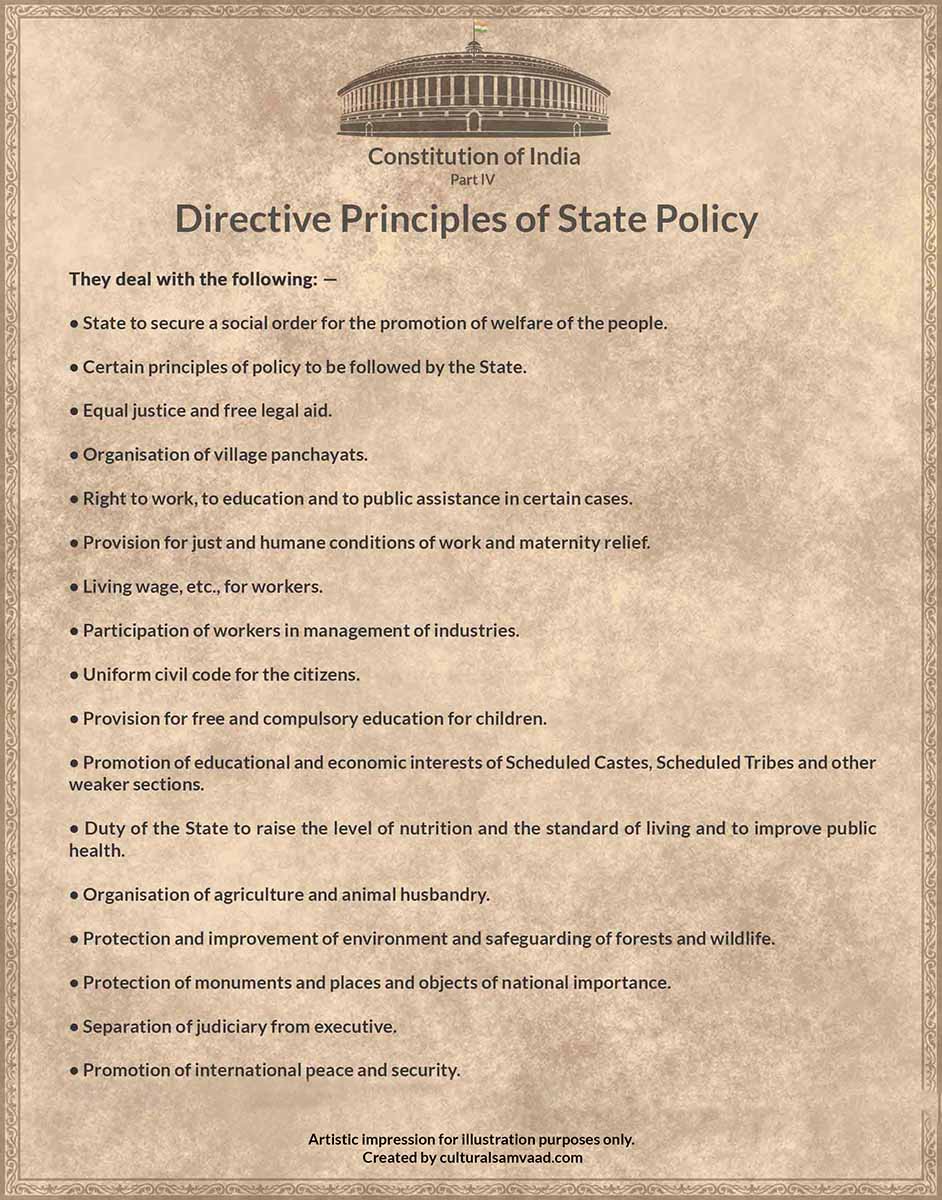
Fundamental Duties
Part IV A of the Constitution which was inserted by the Constitution (Forty-second Amendment) Act, 1976, lays down non-enforceable ‘Fundamental Duties’ of citizens. The Indian tradition has always regarded rights and duties as complementary to each other. Considered in this light, the oft-ignored fundamental duties form critical building blocks of the India that we, the citizens have resolved to build and hence, also form an integral part of the conscience of our constitution.
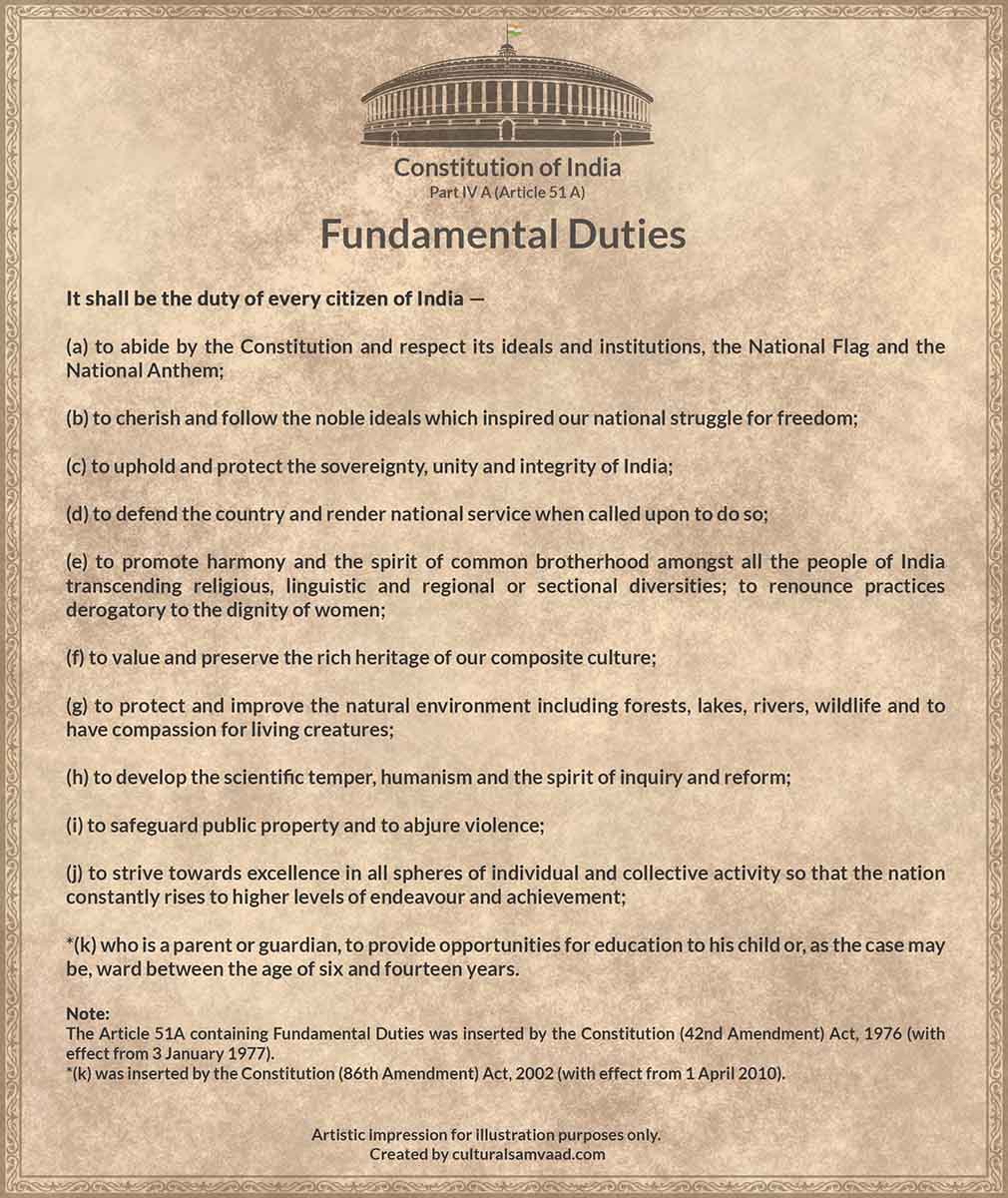
Constitution of India – A Living and Working Document
The Constitution of India is a living document. Multiple amendments have been made to it over the years to accommodate emerging needs and challenges. This process which can be likened to the proverbial ‘churning of the ocean’ is fraught with its own set of risks and challenges. This dynamism, however, is sine qua non for progress and should not and will not cease. It is incumbent upon ‘we, the people of India’ who have adopted and enacted the constitution as the cornerstone of our democracy not only to understand, appreciate and protect its sanctity but also to put it to work as we build a saare jahan se acchan Hindustan (सारे जहाँ से अच्छा हिंदुस्तान).
Editor’s Note:
This note and the accompanying video are meant only to serve as an introduction to some of the basic features of the Constitution of India and should be perused as such. The information is, to the best of our knowledge, based on generally accessible sources which are reliable and has been updated as of January 25, 2020.
References:
- https://www.india.gov.in/my-government/constitution-india/constitution-india-full-text
- Democratic Politics – I. Textbook in Political Science for Class IX. NCERT, 2019-20.
- Granville Austin: The Indian Constitution: Cornerstone of a nation. Oxford University Press, India, 2019.
- Indian Constitution at Work. Textbook in Political Science for Class XI. NCERT, 2019-20.
- Subhash C. Kashyap: Our Constitution: An Introduction to India’s Constitution and Constitutional Law. National Book Trust, India, 1994.


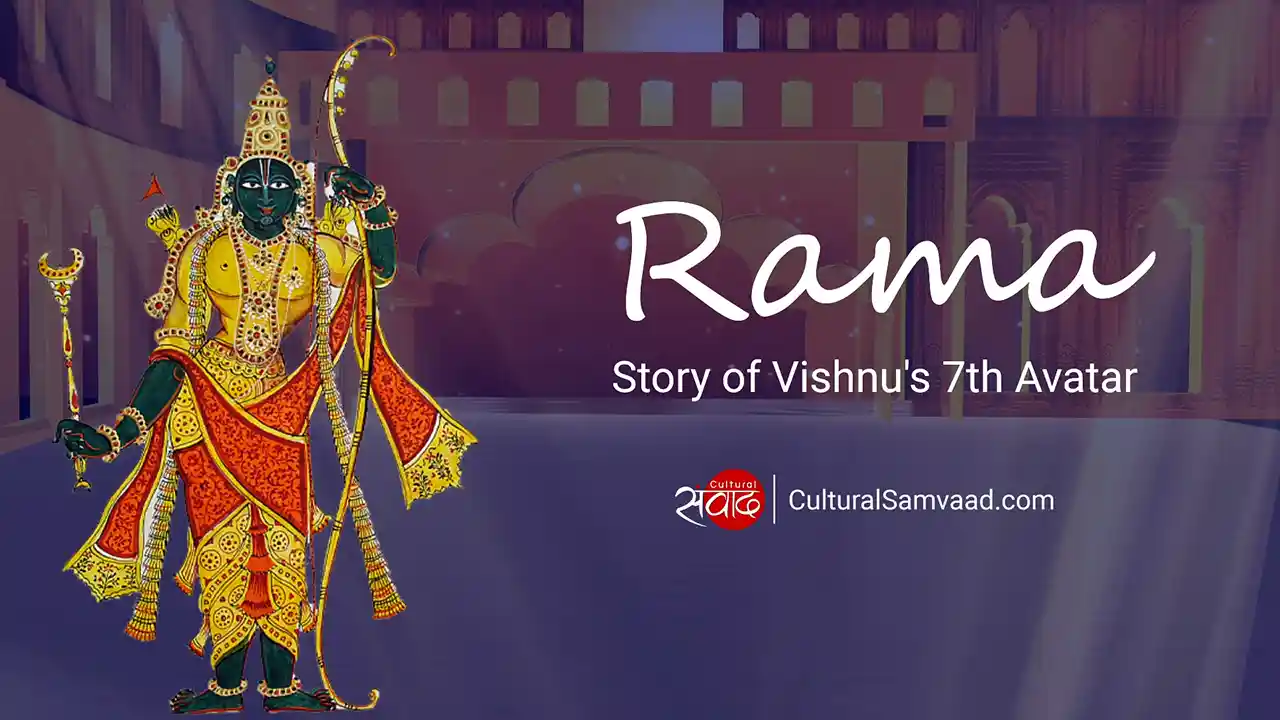
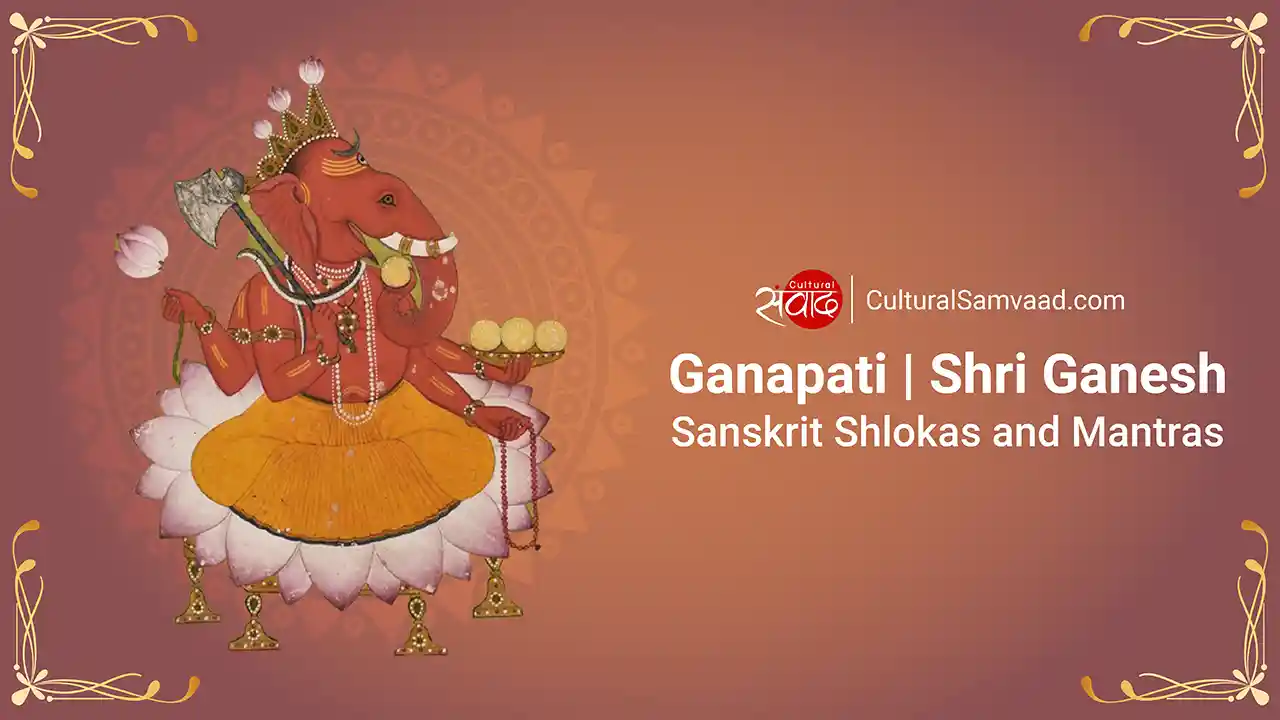


বাংলা তর্জমা চাই।
কি ভাবে কোথায় পাব ?
Dear Dasji,
Currently we do not have team mates who can translate in Bangla. We will definitely try in future. We will be putting up a link in Hindi this week.
Thanks for writing to us.
Ma’am you are so talented ma’am thank you so much for your explan the Indian Constitution
Ma’am your content is beautifully explained & justified. Thanx 4 writing. It’s help me alot. 🙂
Saree jha se achacha india amra